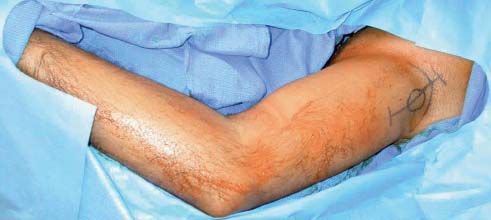Case 104 Right Axillary Mass with Tinel Sign Fig. 104.1 Intraoperative photograph demonstrating location of the mass in the axilla of the right upper extremity (circle) and placement of the overlying incision. The arm is draped into the field to facilitate interpretation of intraoperative nerve stimulation. Specifically, the incision along the course of the nerve to permit tumor removal is located along a portion of the nerve that, when stimulated, does not produce muscle contractions, so that the risk of neurologic injury is reduced.

 Clinical Presentation
Clinical Presentation
 Questions
Questions
 Answers
Answers
< div class='tao-gold-member'>
104 Right Axillary Mass with Tinel Sign
Only gold members can continue reading. Log In or Register to continue

Full access? Get Clinical Tree


